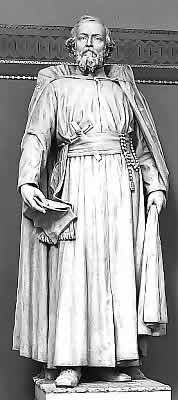Jacques Marquette
| Jacques Marquette | |
|---|---|
|
1869 portrait of Marquette | |
| Born |
June 1, 1637 Laon, Kingdom of France |
| Died |
May 18, 1675 (aged 37) near Ludington, Michigan |
| Other names | Pere Marquette |
Father Jacques Marquette S.J. (June 1, 1637 – May 18, 1675),[1] sometimes known as Père Marquette or James Marquette,[2] was a French Jesuit missionary who founded Michigan's first European settlement, Sault Ste. Marie, and later founded St. Ignace, Michigan. In 1673 Father Marquette and Louis Jolliet were the first Europeans to explore and map the northern portion of the Mississippi River Valley.
Biography
Jacques Marquette was born in Laon, France, on June 1, 1637, and joined the Society of Jesus at age 17.[3] After he worked and taught in France for several years, the Jesuits assigned him to New France in 1666 as a missionary to the indigenous peoples of the Americas. He showed great proficiency in learning the local languages, especially Huron. In 1668 Father Marquette was moved by his superiors to missions farther up the St. Lawrence River in the western Great Lakes region. He helped found missions at Sault Ste. Marie in present-day Michigan in 1668, St. Ignace in 1671 (St. Ignace Mission),[3] and at La Pointe, on Lake Superior near the present-day city of Ashland, Wisconsin. At La Pointe he encountered members of the Illinois tribes, who told him about the important trading route of the Mississippi River. They invited him to teach their people, whose settlements were mostly farther south. Because of wars between the Hurons at La Pointe and the neighboring Lakota people, Father Marquette left the mission and went to the Straits of Mackinac; he informed his superiors about the rumored river and requested permission to explore it.
Leave was granted, and in 1673 Marquette joined the expedition of Louis Jolliet, a French-Canadian explorer. They departed from St. Ignace on May 17, with two canoes and five voyageurs of French-Indian ancestry (Métis).[3] They followed Lake Michigan to Green Bay and up the Fox River, nearly to its headwaters. From there, they were told to portage their canoes a distance of slightly less than two miles through marsh and oak plains to the Wisconsin River. Many years later, at that point the town of Portage, Wisconsin was built, named for the ancient path between the two rivers. From the portage, they ventured forth, and on June 17 they entered the Mississippi near present-day Prairie du Chien, Wisconsin.
The Joliet-Marquette expedition traveled to within 435 miles (700 km) of the Gulf of Mexico but turned back at the mouth of the Arkansas River. By this point they had encountered several natives carrying European trinkets, and they feared an encounter with explorers or colonists from Spain.[5] They followed the Mississippi back to the mouth of the Illinois River, which they learned from local natives provided a shorter route back to the Great Lakes. They reached Lake Michigan near the site of modern-day Chicago, by way of the Chicago Portage. In September Marquette stopped at the mission of St. Francis Xavier, located in present-day Green Bay, Wisconsin, while Jolliet returned to Quebec to relate the news of their discoveries.
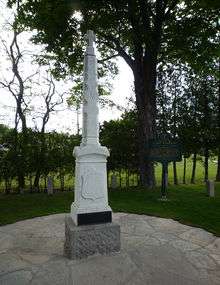
Marquette and his party returned to the Illinois Territory in late 1674, becoming the first Europeans to winter in what would become the city of Chicago. As welcomed guests of the Illinois Confederation, the explorers were feasted en route and fed ceremonial foods such as sagamite.[6]
In the spring of 1675, Marquette traveled westward and celebrated a public mass at the Grand Village of the Illinois near Starved Rock. A bout of dysentery which he had contracted during the Mississippi expedition sapped his health. On the return trip to St. Ignace, he died at age 37 near the modern town of Ludington, Michigan.
A Michigan Historical Marker at this location reads:
| “ | Father Jacques Marquette, the great Jesuit missionary and explorer, died and was buried by two French companions somewhere along the Lake Michigan shore on May 18, 1675. He had been returning to his mission at St. Ignace which he had left in 1673 to go exploring in the Mississippi country. The exact location of his death has long been a subject of controversy. A spot close to the southeast slope of this hill, near the ancient outlet of the Pere Marquette River, corresponds with the death site as located by early French accounts and maps and a constant tradition of the past. Marquette's remains were reburied at St. Ignace in 1677.[7] | ” |
The Ojibway Museum on State Street in downtown St. Ignace is in a building that was constructed adjacent to Marquette's gravesite during urban development.
Legacy and honors
Father Marquette is memorialized in the names of many towns, geographical locations, parks, a major university, and other institutions:
- Marquette County, Michigan,[8] Marquette County, Wisconsin
- The communities of Marquette, Michigan; Marquette, Wisconsin; Marquette, Iowa; Marquette, Illinois; Marquette Heights, Illinois; Pere Marquette Charter Township, Michigan;[9] and others
- Marquette University in Milwaukee, Wisconsin
- Marquette Island in Lake Huron
- Pere Marquette River in Michigan
- Pere Marquette Park in Milwaukee, WI
- Pere Marquette State Park near Grafton, Illinois
- Father Marquette National Memorial near St. Ignace, Michigan[10]
- Pere Marquette Beach, a public beach in Muskegon, Michigan
- Pere Marquette State Forest, in Michigan
- Pere Marquette Hotel, Peoria, Illinois
- The Pere Marquette Railway
- "Cité Marquette", former US-City-Base (1956–1966) built by Americans based on the NATO Air Force Base in Couvron (38th Bombardment Wing), Laon, France (his birthplace).
- Marquette Transportation Company, a towboat company using a silhouette of the Pere in his canoe as their emblem.[11]
- Marquette Building in Chicago, Illinois
- Marquette Elementary School, Chicago, Illinois
- Marquette Park, Chicago, Illinois
- Marquette Road, Chicago, Illinois
In addition, statues in Marquette's honor have been erected in several places, including the Prairie du Chien Post Office; Parliament Building, Quebec, Canada; at Marquette University; Detroit, Michigan; and Fort Mackinac, Michigan. Other types of memorials were erected, including those at his birthplace in Laon, France; and St. Mary's Church, Utica, Illinois.
The Legler Branch of the Chicago Public Library displays "Wilderness, Winter River Scene," a restored mural by Midwestern artist R. Fayerweather Babcock. The mural depicts Father Jacques Marquette and Native Americans trading by a river. Commissioned for Legler Branch in 1934, the mural was funded by the Works Projects Administration.[12]
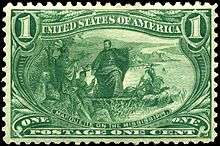 1898 issue |
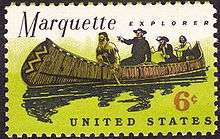 1968 issue |
Marquette was honored on the one-cent Trans-Mississippi Exposition issue, which shows him on the Mississippi River[13] and by a 6-cent stamp issued September 20, 1968. It was the 300th anniversary of his establishing the oldest permanent settlement in Michigan at Sault Sainte Marie.[14]
Photo gallery
 Sketch of Father Marquette
Sketch of Father Marquette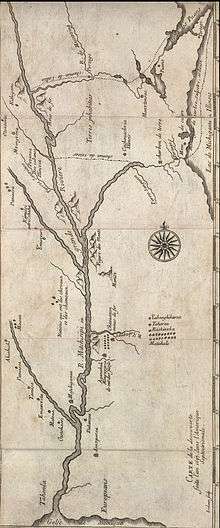 Ca. 1681 map of Marquette and Jolliet's 1673 expedition
Ca. 1681 map of Marquette and Jolliet's 1673 expedition Michigan Historical Marker: "Marquette's Death"
Michigan Historical Marker: "Marquette's Death"- Memorial to Marquette in his birthplace of Laon, France
 Alfred Laliberté's Marquette sculpture at Parliament Building (Quebec)
Alfred Laliberté's Marquette sculpture at Parliament Building (Quebec)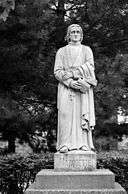 Statue of Marquette in Detroit, Michigan
Statue of Marquette in Detroit, Michigan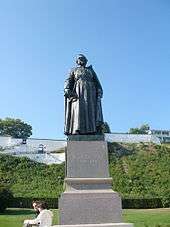 Statue of Marquette at Fort Mackinac
Statue of Marquette at Fort Mackinac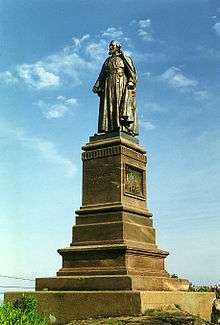 Statue of Marquette in Marquette, Michigan
Statue of Marquette in Marquette, Michigan Statue of Marquette in Prairie du Chien, Wisconsin
Statue of Marquette in Prairie du Chien, Wisconsin Pere Marquette Memorial in Utica, IL
Pere Marquette Memorial in Utica, IL
See also
- Jacques Marquette (sculpture), a 2005 public art work by artist Ronald Knepper
- Pere Jacques Marquette (Queoff), a 1987 public art work by Tom Queoff
- Sagamite
- Marquette (disambiguation) for other places, buildings and geographic objects named after Father Jacques Marquette.
- Chicago Portage
- Chicago Portage National Historic Site
Notes
- ↑ "Jacques Marquette". Encyclopædia Britannica.
- ↑ Catholic Encyclopedia (1913): Archdiocese of Chicago, Retrieved February 23, 2012
- 1 2 3 ""Jacques Marquette", Biography". biography.com.
- ↑ The painting was rendered as an engraving on a US commemorative postage stamp, 1898 (Illustration)
- ↑ Catton, Bruce (1984). Michigan: A History, p. 14. W. W. Norton & Company. ISBN 0-393-30175-3
- ↑ "Odd Wisconsin Archive: Beer and Sweet Corn". wisconsinhistory.org. Archived from the original on 21 September 2013.
- ↑ "Michigan Historical Markers". michmarkers.com. Archived from the original on 2009-03-31. Retrieved 2008-07-26.
- ↑ "Bibliography on Marquette County". Clarke Historical Library, Central Michigan University. Retrieved January 20, 2013.
- ↑ "Focus on our history: How county was named". Ludington Daily News. October 3, 1987. p. 2. Retrieved 30 April 2015.
- ↑ "Term: Marquette, Jacques 1637 – 1675". wisconsinhistory.org. Archived from the original on 3 November 2013.
- ↑ "Home | Marquette Transportation Company". marquettetrans.com. Marquette Transportation Company LLC. 2015. Retrieved 7 May 2015.
- ↑ Chicago Public Library. About Legler Branch.
- ↑ Haimann, Alexander T., "Arago: people, postage & the post. 1-cent Marquette on the Mississippi". National Postal Museum. Accessed May 2, 2017.
- ↑ Tessa Sabol. "Trans-Mississippi Exposition Commemorative Stamp Issue and National Identity at the Turn of the Twentieth Century". National Postal Museum. Accessed May 2, 2017.
External links
| Wikimedia Commons has media related to Jacques Marquette. |
- Biography at the Dictionary of Canadian Biography Online
- Iconographic sources of jesuit father Jacques Marquette fictitious portraits, Web Robert Derome, Professeur honoraire d'histoire de l'art, Université du Québec à Montréal.
- The Jesuit Relations and Allied Documents 1610 to 1791, including Marquette's journal (Chapters CXXXVI – CXXXVIII)

- Thwaites, Reuben G. Father Marquette New York: D. Appleton & Company, 1902.
